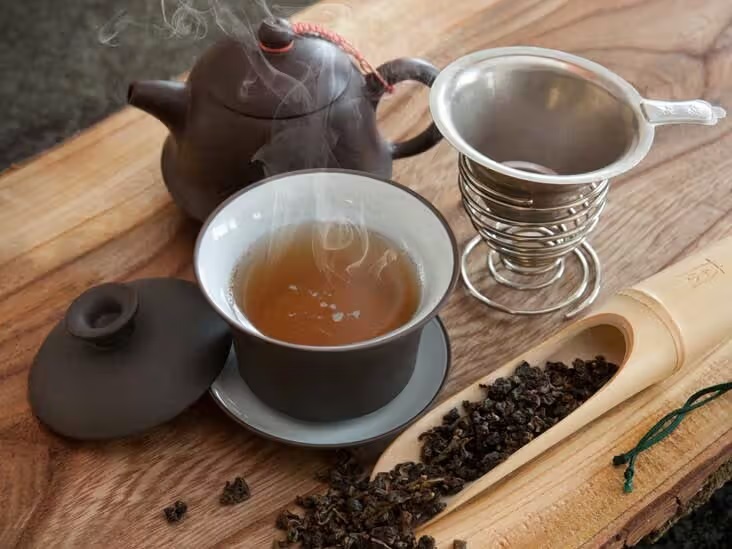Oolong tea, also known as wulong or black dragon tea, is a beloved beverage with a rich history, complex flavor profile, and numerous health benefits. Originating from China’s Fujian Province, this tea has been cherished for centuries for its distinctive taste, floral aroma, and potential wellness properties. In this comprehensive guide, we will jump into the origins, production methods, varieties, health benefits, and cultural significance of oolong tea, as well as tips for brewing and enjoying this remarkable tea.

Origins and History
The origins of oolong tea can be traced back to China’s Fujian Province, where tea cultivation and production have flourished for thousands of years. Legend has it that this tea was discovered by accident during the Ming Dynasty (1368-1644 CE) when a tea farmer accidentally left freshly harvested tea leaves out in the sun to wither. Upon returning, he found that the leaves had partially oxidized, resulting in a unique flavour profile that was neither green tea nor black tea.

Over time, tea artisans in Fujian Province refined the production techniques for oolong tea, experimenting with different levels of oxidation, rolling, and firing to achieve the desired taste and aroma. It soon gained popularity among tea connoisseurs for its complex flavor, floral fragrance, and soothing properties.
As trade routes expanded during the Qing Dynasty (1644-1912 CE), this beverage became a prized commodity in international markets, particularly in Europe and North America. Its unique taste and cultural significance earned it a reputation as one of the finest teas in the world, cherished for its ability to delight the senses and nourish the body and soul.
Don’t Miss: Jasmine Tea: A Fragrant Journey To Health & Wellness
Production Methods
The production of oolong tea is a labor-intensive process that requires skill, patience, and attention to detail. While specific techniques may vary depending on the region and style of the tea, the basic steps typically involve withering, oxidation, rolling, drying, and roasting.
Withering
Freshly harvested tea leaves are spread out on bamboo trays or racks and allowed to wither in the sun or indoors for a period of time. This withering process reduces moisture content and makes the leaves more pliable for rolling and shaping.
Oxidation
After withering, the tea leaves are gently shaken or tossed to bruise the edges and initiate oxidation. Oxidation is a crucial step in oolong tea production, as it allows the leaves to develop their characteristic flavors and aromas. The level of oxidation can vary widely, ranging from lightly oxidized (green oolong) to heavily oxidized (dark oolong).
Rolling
Once the desired level of oxidation is achieved, the tea leaves are carefully rolled or twisted by hand or machine to release their juices and shape them into tight, compact balls or strips. This rolling process helps to further enhance the flavor and aroma of the tea.
Drying
After rolling, the tea leaves are spread out on trays or bamboo mats and dried in the sun or using hot air or charcoal-fired ovens. Drying removes residual moisture from the leaves and helps preserve their freshness and flavor.
Roasting
In some styles of oolong tea, the dried leaves are subjected to a final roasting or firing process to further develop their flavors and aromas. Roasting may be done over charcoal or in electric ovens, with varying degrees of heat and duration depending on the desired outcome.
Throughout the production process, tea artisans carefully monitor factors such as temperature, humidity, and handling techniques to ensure the quality and consistency of the finished tea. The artistry and craftsmanship involved in oolong tea production reflect centuries of tradition and cultural heritage, making each batch of tea a testament to the dedication and skill of the tea artisans.
Varieties of Oolong Tea
Oolong tea comes in a wide range of varieties, each distinguished by factors such as oxidation level, growing region, and production techniques. Some of the most popular varieties of this tea include:
- Tieguanyin: Also known as Iron Goddess of Mercy, Tieguanyin is a lightly oxidized oolong tea with a smooth, creamy texture and floral aroma. It is grown primarily in China’s Fujian Province and Taiwan’s Anxi County.
- Da Hong Pao: Translating to Big Red Robe, Da Hong Pao is a heavily oxidized tea with a rich, full-bodied flavor and hints of caramel and roasted nuts. It is cultivated in the Wuyi Mountains of China’s Fujian Province.
- Dong Ding: Named after the mountain where it is grown, Dong Ding oolong tea is a medium to heavily oxidized tea with a balanced flavor and fruity aroma. It is produced in Taiwan’s Nantou County.
- Formosa Oolong: This category includes a diverse range of this teas from Taiwan, known for their floral aroma, fruity flavor, and smooth, creamy texture. Formosa oolongs are grown in various regions across the island.
- Phoenix Dancong: Grown in the Phoenix Mountain region of China’s Guangdong Province, Phoenix Dancong oolong tea is known for its complex flavor profile and distinct floral and fruity aromas. It comes in a variety of cultivars, each with its unique characteristics.
Each variety of this tea offers a unique sensory experience, allowing tea enthusiasts to explore different flavor profiles and discover their preferred brew. From light and floral to dark and robust, there’s an oolong tea to suit every palate and occasion.
Health Benefits of Oolong Tea
Oolong tea offers a wide range of potential health benefits attributed to its antioxidant properties, vitamins, minerals, and other bioactive compounds. Some of the key health benefits of this healthy beverage are as follows.
Antioxidant Protection
This tea is rich in antioxidants, such as catechins, flavonoids, and polyphenols, which help protect cells from oxidative damage caused by free radicals. In addition, antioxidants may reduce the risk of chronic diseases, including heart disease, cancer, and neurodegenerative disorders.

Weight Management
Some studies suggest that oolong tea may aid in weight management by boosting metabolism, increasing energy expenditure, and promoting fat burning. Drinking this beverage as part of a healthy diet and lifestyle may help support weight loss and maintenance goals.

Supports Heart Health
Regular consumption of this tea may support heart health by lowering LDL cholesterol levels, reducing blood pressure, and improving blood vessel function. The polyphenols and catechins found in it have been shown to have cardioprotective effects and may reduce the risk of heart disease and stroke.

Improves Digestive System
Oolong tea’s mild stimulant properties can aid in digestion and alleviate digestive discomfort, such as bloating, gas, and indigestion. It may help stimulate digestion, reduce inflammation, and promote overall gastrointestinal health.

Promotes Mental Well-Being
The aroma of this beverage has calming and uplifting effects on mood and mental well-being. It may help reduce stress, anxiety, and depression, promote relaxation, and improve overall cognitive function and emotional resilience.

Supports Bone Health
Oolong tea contains minerals such as calcium, magnesium, and manganese, which are essential for maintaining strong and healthy bones. Regular consumption of this tea may help improve bone density and reduce the risk of osteoporosis.

Improves Dental Health
The fluoride content in this tea may help promote dental health by strengthening tooth enamel, reducing the risk of cavities, and preventing gum disease. Drinking this beverage regularly may contribute to healthier teeth and gums and fresher breath.

Provides Immune Support
The antioxidants and vitamins found in oolong tea can strengthen the immune system and help defend the body against infections and illness. Regular consumption of this tea may reduce the frequency and severity of colds, flu, and other common infections.
Improve Skin Health
This tea’s antioxidant properties can benefit skin health by protecting against free radical damage and premature aging. It may help maintain skin elasticity, reduce inflammation, and promote collagen production for smoother, more youthful-looking skin.
Respiratory Health
The aroma of oolong tea has been traditionally used to relieve respiratory symptoms, such as coughs, congestion, and sore throat. Inhaling the fragrance of this tea may help open up the airways and promote easier breathing.

While further research is needed to fully understand the health benefits of this tea, its rich nutritional profile and potential wellness properties make it a valuable addition to a balanced diet and healthy lifestyle.
Cultural Significance
Oolong tea holds significant cultural and symbolic importance in China and other regions where it is consumed. In Chinese culture, it is often associated with elegance, refinement, and hospitality, making it a popular beverage for social gatherings, ceremonies, and celebrations.
This tea is also deeply intertwined with Chinese tea ceremonies, where it is served as a gesture of respect and reverence to guests. The preparation and serving of this beverage follow traditional rituals and etiquette, creating a sense of harmony and balance between the host and guests.
In addition to its cultural significance, oolong tea has inspired artists, poets, and writers throughout history, who have praised its beauty, fragrance, and complexity in their works. From ancient Chinese paintings depicting tea gatherings to modern literary references in poetry and prose, this tea continues to inspire creativity and evoke a sense of tranquility and contemplation.
Tips for Brewing and Enjoying Oolong Tea
Brewing oolong tea is a time-honored ritual that allows tea enthusiasts to savor its complex flavors and aromas to the fullest. Here are some tips for brewing and enjoying this tea.
- Select high-quality tea made from fresh tea leaves and processed using traditional methods for the best flavor and aroma.
- Use fresh, filtered water to brew the tea, as impurities in tap water can affect the taste and clarity of the tea.
- Heat water to the optimal temperature for brewing oolong tea, typically around 190-200°F (87-93°C) for lightly oxidized oolongs and 200-212°F (93-100°C) for heavily oxidized oolongs. Avoid boiling water, as it can scald the tea leaves and result in a bitter taste.
- Steep the tea for 2-3 minutes for lightly oxidized varieties and 3-5 minutes for heavily oxidized varieties to extract the full range of flavors and aromas. Adjust the steeping time according to personal preference for stronger or milder tea.
- Before taking a sip, take a moment to inhale the fragrant aroma of the tea, allowing the floral, fruity, and earthy notes to tantalize your senses and evoke a sense of relaxation and well-being.
- Pour the brewed oolong tea into a teacup or glass, and savor each sip slowly, allowing the flavors to unfold on your palate. This beverage can be enjoyed hot or cold, depending on personal preference and the season.
- This tea is also known for its ability to be steeped multiple times, with each infusion revealing new layers of flavor and complexity. Experiment with different steeping times and water temperatures to discover your preferred brewing method.
The Bottom Line
Oolong tea offers a fascinating journey through tradition and taste, with its rich history, complex flavor profile, and potential health benefits. Whether enjoyed as a daily ritual or shared with friends and loved ones, this tea continues to captivate tea enthusiasts around the world with its timeless charm and elegance. By exploring the origins, production methods, varieties, health benefits, and cultural significance of oolong tea, we gain a deeper appreciation for this remarkable beverage and its enduring legacy in tea culture. So brew a pot of this healthy beverage, take a moment to savor its exquisite flavors and aromas, and embark on a journey of tranquillity and well-being with each sip. Hopefully, you found this article helpful and enjoyable enough. If you really did then let us know your valuable unfiltered thoughts in the comment section down below. Thanks for visiting and appreciating our work.
